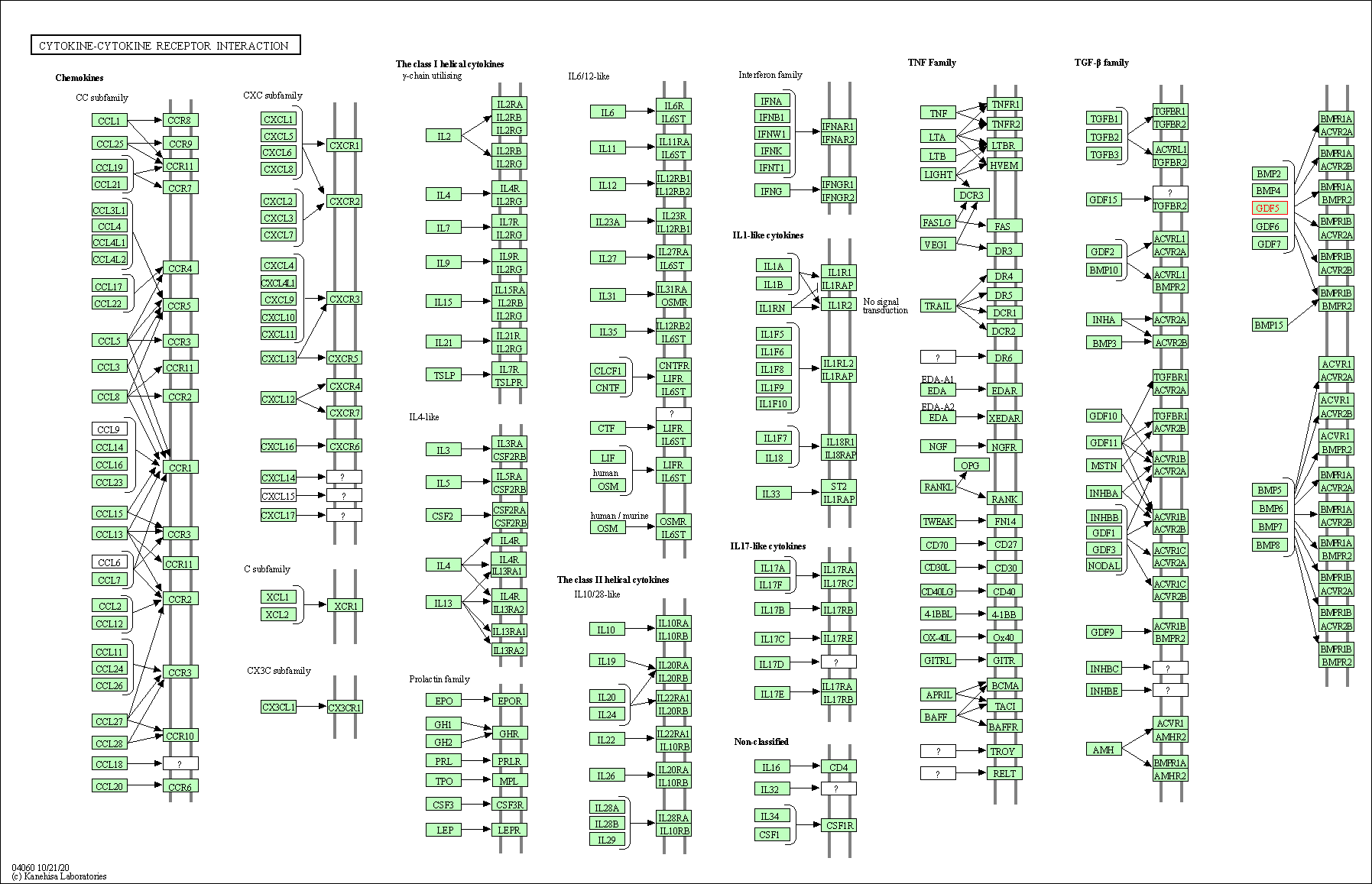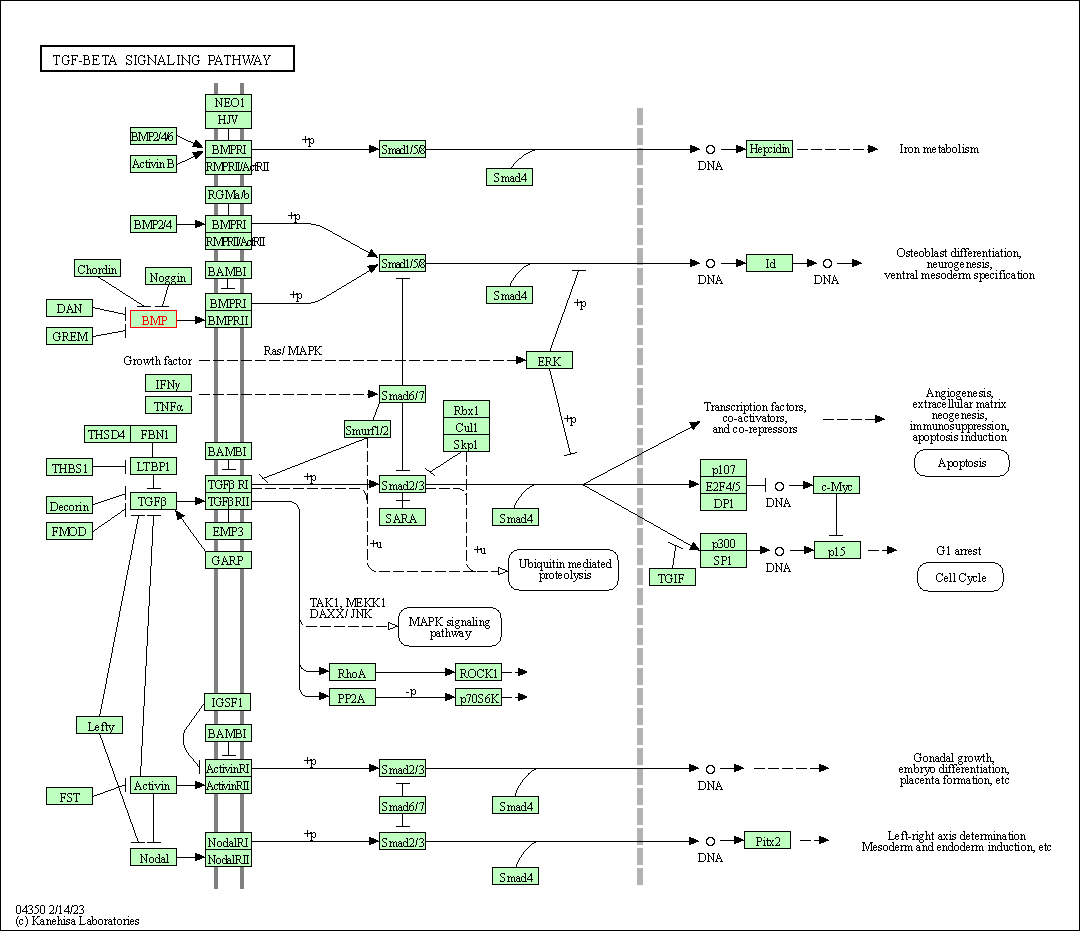Target Information
| Target General Information | Top | |||||
|---|---|---|---|---|---|---|
| Target ID |
T96760
(Former ID: TTDI02078)
|
|||||
| Target Name |
Growth/differentiation factor 5 (GDF-5)
|
|||||
| Synonyms |
Radotermin; Lipopolysaccharide-associated protein 4; LPS-associated protein 4; LAP-4; Cartilagederived morphogenetic protein 1; Cartilage-derived morphogenetic protein 1; CDMP1; CDMP-1; Bone morphogenetic protein 14; BMP14; BMP-14
Click to Show/Hide
|
|||||
| Gene Name |
GDF5
|
|||||
| Target Type |
Clinical trial target
|
[1] | ||||
| Disease | [+] 1 Target-related Diseases | + | ||||
| 1 | Periodontal disease [ICD-11: DA0C] | |||||
| Function |
During cartilage development regulates differentiation of chondrogenic tissue through two pathways. Firstly, positively regulates differentiation of chondrogenic tissue through its binding of high affinity with BMPR1B and of less affinity with BMPR1A, leading to induction of SMAD1-SMAD5-SMAD8 complex phosphorylation and then SMAD protein signaling transduction. Secondly, negatively regulates chondrogenic differentiation through its interaction with NOG. Required to prevent excessive muscle loss upon denervation. This function requires SMAD4 and is mediated by phosphorylated SMAD1/5/8. Binds bacterial lipopolysaccharide (LPS) and mediates LPS-induced inflammatory response, including TNF secretion by monocytes. Growth factor involved in bone and cartilage formation.
Click to Show/Hide
|
|||||
| BioChemical Class |
Growth factor
|
|||||
| UniProt ID | ||||||
| Sequence |
MRLPKLLTFLLWYLAWLDLEFICTVLGAPDLGQRPQGTRPGLAKAEAKERPPLARNVFRP
GGHSYGGGATNANARAKGGTGQTGGLTQPKKDEPKKLPPRPGGPEPKPGHPPQTRQATAR TVTPKGQLPGGKAPPKAGSVPSSFLLKKAREPGPPREPKEPFRPPPITPHEYMLSLYRTL SDADRKGGNSSVKLEAGLANTITSFIDKGQDDRGPVVRKQRYVFDISALEKDGLLGAELR ILRKKPSDTAKPAAPGGGRAAQLKLSSCPSGRQPASLLDVRSVPGLDGSGWEVFDIWKLF RNFKNSAQLCLELEAWERGRAVDLRGLGFDRAARQVHEKALFLVFGRTKKRDLFFNEIKA RSGQDDKTVYEYLFSQRRKRRAPLATRQGKRPSKNLKARCSRKALHVNFKDMGWDDWIIA PLEYEAFHCEGLCEFPLRSHLEPTNHAVIQTLMNSMDPESTPPTCCVPTRLSPISILFID SANNVVYKQYEDMVVESCGCR Click to Show/Hide
|
|||||
| 3D Structure | Click to Show 3D Structure of This Target | AlphaFold | ||||
| Cell-based Target Expression Variations | Top | |||||
|---|---|---|---|---|---|---|
| Cell-based Target Expression Variations | ||||||
| Different Human System Profiles of Target | Top |
|---|---|
|
Human Similarity Proteins
of target is determined by comparing the sequence similarity of all human proteins with the target based on BLAST. The similarity proteins for a target are defined as the proteins with E-value < 0.005 and outside the protein families of the target.
A target that has fewer human similarity proteins outside its family is commonly regarded to possess a greater capacity to avoid undesired interactions and thus increase the possibility of finding successful drugs
(Brief Bioinform, 21: 649-662, 2020).
Human Pathway Affiliation
of target is determined by the life-essential pathways provided on KEGG database. The target-affiliated pathways were defined based on the following two criteria (a) the pathways of the studied target should be life-essential for both healthy individuals and patients, and (b) the studied target should occupy an upstream position in the pathways and therefore had the ability to regulate biological function.
Targets involved in a fewer pathways have greater likelihood to be successfully developed, while those associated with more human pathways increase the chance of undesirable interferences with other human processes
(Pharmacol Rev, 58: 259-279, 2006).
Biological Network Descriptors
of target is determined based on a human protein-protein interactions (PPI) network consisting of 9,309 proteins and 52,713 PPIs, which were with a high confidence score of ≥ 0.95 collected from STRING database.
The network properties of targets based on protein-protein interactions (PPIs) have been widely adopted for the assessment of target’s druggability. Proteins with high node degree tend to have a high impact on network function through multiple interactions, while proteins with high betweenness centrality are regarded to be central for communication in interaction networks and regulate the flow of signaling information
(Front Pharmacol, 9, 1245, 2018;
Curr Opin Struct Biol. 44:134-142, 2017).
Human Similarity Proteins
Human Pathway Affiliation
Biological Network Descriptors
|
|
|
There is no similarity protein (E value < 0.005) for this target
|
| KEGG Pathway | Pathway ID | Affiliated Target | Pathway Map |
|---|---|---|---|
| Cytokine-cytokine receptor interaction | hsa04060 | Affiliated Target |

|
| Class: Environmental Information Processing => Signaling molecules and interaction | Pathway Hierarchy | ||
| TGF-beta signaling pathway | hsa04350 | Affiliated Target |

|
| Class: Environmental Information Processing => Signal transduction | Pathway Hierarchy | ||
| Hippo signaling pathway | hsa04390 | Affiliated Target |

|
| Class: Environmental Information Processing => Signal transduction | Pathway Hierarchy | ||
| Degree | 5 | Degree centrality | 5.37E-04 | Betweenness centrality | 2.03E-04 |
|---|---|---|---|---|---|
| Closeness centrality | 1.84E-01 | Radiality | 1.31E+01 | Clustering coefficient | 3.00E-01 |
| Neighborhood connectivity | 1.92E+01 | Topological coefficient | 4.42E-01 | Eccentricity | 13 |
| Download | Click to Download the Full PPI Network of This Target | ||||
| Target Regulators | Top | |||||
|---|---|---|---|---|---|---|
| Target-regulating microRNAs | ||||||
| Target Profiles in Patients | Top | |||||
|---|---|---|---|---|---|---|
| Target Expression Profile (TEP) | ||||||
| Drug Resistance Mutation (DRM) | ||||||
| Target Affiliated Biological Pathways | Top | |||||
|---|---|---|---|---|---|---|
| KEGG Pathway | [+] 3 KEGG Pathways | + | ||||
| 1 | Cytokine-cytokine receptor interaction | |||||
| 2 | TGF-beta signaling pathway | |||||
| 3 | Hippo signaling pathway | |||||
| NetPath Pathway | [+] 2 NetPath Pathways | + | ||||
| 1 | IL1 Signaling Pathway | |||||
| 2 | TGF_beta_Receptor Signaling Pathway | |||||
| Panther Pathway | [+] 1 Panther Pathways | + | ||||
| 1 | TGF-beta signaling pathway | |||||
| Reactome | [+] 1 Reactome Pathways | + | ||||
| 1 | Molecules associated with elastic fibres | |||||
| WikiPathways | [+] 2 WikiPathways | + | ||||
| 1 | Differentiation Pathway | |||||
| 2 | Elastic fibre formation | |||||
| References | Top | |||||
|---|---|---|---|---|---|---|
| REF 1 | Superior effect of MD05, beta-tricalcium phosphate coated with recombinant human growth/differentiation factor-5, compared to conventional bone substitutes in the rat calvarial defect model. J Periodontol. 2006 Sep;77(9):1582-90. | |||||
| REF 2 | ClinicalTrials.gov (NCT01124006) A Multicenter, Randomized, Double-blind, Placebo Controlled, Clinical Trial to Evaluate the Safety, Tolerability and Preliminary Effectiveness of 2 Doses of Intradiscal rhGDF-5 (Single Administration) for the Treatment of Early Stage Lumbar Disc Degeneration. U.S. National Institutes of Health. | |||||
If You Find Any Error in Data or Bug in Web Service, Please Kindly Report It to Dr. Zhou and Dr. Zhang.

